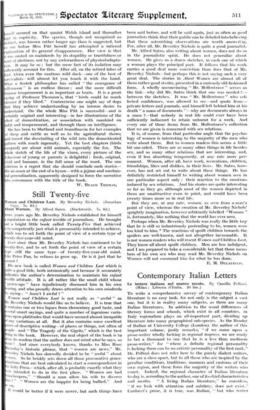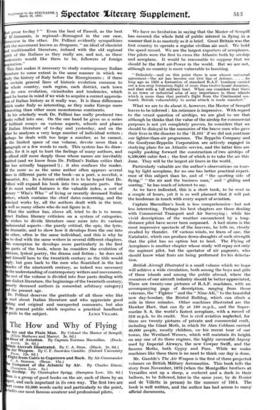Contemporary Italian Letters
Le lettere italiane nel nostro secolo. By Camillo Pellizzi. (Milan : Libreria d'Italia. 39 lire.) To write a comprehensive survey of contemporary Italian literature is no easy task, for not only is the subject .a vast one, but -it is in reality many subjects, as there are many Italian literatures. In addition to the usual differences of literary forms and schools, which exist in all countries, in Italy regionalism plays an all-important part, dividing up literature into many geographical sub-species. As the Reader of Italian at University College (London), the author of this important volume, justly remarks, "if we come upon a prose-writer wholly lacking in regional impress, we are ready to bet a thousand to one that he is a less than mediocre prose-writer," for "where a definite regional personality is lacking there can be no artistic personality of the first rank." Dr. Pellizzi does not refer here to the purely dialect writers, who are a class apart, but to all those who are inspired by the peculiar conditions, traditions, manners and customs of their own region, and these form the majority of the writers who count. Indeed, the regional character of Italian literature to-day is, according to the author, one of its chief characteristics and merits. "A living Italian literature," he considers, " if - we look with attention and subtlety, does not exist." Carducci's prose, it is true, was Italian, "but who writes t prose to-day ? " Even the best of Pascoli, as the best D'Annunzio, is regional—Romagnol in the one case, bruzzese in the other. Dr. Pellizzi evidently sympathizes 'th the movement known as Strapaese, "an ideal of classicist d traditionalist literature, imbued with the old regional pint of the Italians as they really are, and not, as these lodernists would like them to be, followers of foreign spiration."
This fact makes it necessary to study contemporary Italian erature to some extent in the same manner in which we udy the history of Italy before the Risorgimento ; if there re certain general lines of historic evolution common to
e whole country, each region, each district, each town
its own evolution, vicissitudes and tendencies, which ust be borne in mind if we wish to acquire a correct apprecia- on of Italian history as it really was. It is these differences hich make Italy so interesting, as they make Europe more teresting than other more monotonous continents.
In his scholarly work Dr. Pellizzi has really produced two i.ks rolled into one. On the one hand he gives us a series
f brilliant essays on various aspects, schools and phases I Italian literature of to-day and yesterday, and on the ther he analyses a very large number of individual writers ; rhaps he deals with too large a number, as he cannot, the limited space of one volume, devote more than a ragraph or a few words to each. This system has its draw- ks, for it is apt to hurt the feelings of many authors, and offend still more deeply those whose names are inevitably Dated (and we know from Dr. Pellizzi's Italian critics that . ' has actually happened !) ; it also confuses the reader, the more so as the same author often appears several es in different parts of the book—as a poet, a novelist, s. raniatist, &c. In a future edition it is to be hoped that Dr. llizzi will expand his book into two separate parts. Ope f its most useful features is the valuable index, a sort of terary "Who's Who" of living or recently deceased Italian titers, which contains the chief dates concerning, and the rineipal works by, all the authors dealt with in the text, well as many others who do not figure in it.
What the author has, above all, tried to do is to recon- met Italian literary criticism on a system of categories. wishes to divide literature once more into its various: damental aspects—the purely critical, the epic, the lyric, dramatic, and to show how it develops from the one into
e other, often in the same individual, and this is why he as to deal with the same writers in several different chapters. Is conception he develops more particularly in the first o parts of the book, where he, considers the evolution of 'ficism, lyrical poetry, the drama and fiction ; he does not. it himself here to the twentieth century as the title would ply, but goes back to the men who flourished in the last eeades of the nineteenth century, as indeed was necessary in the understanding of contemporary writers and movements. e rest of the volume is divided into four parts dealing with lire dialect literature, the beginnings of The twentieth century,. ntly deceased authors (a somewhat arbitrary category) d the present age.
Dr. Pellizzi deserves the gratitude of all -those who like read about Italian literature and who appreciate good Hag and original and unexpected comments, but also the general public which requires a practical handbook















































 Previous page
Previous page